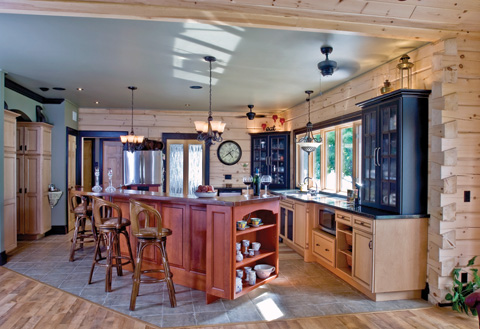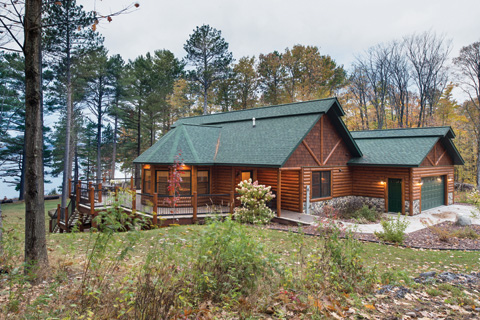The process of building a custom log or timber home is the crossroads of personal preference, cost efficiency, and technical necessity to produce the right balance of aesthetics and sound, quality construction. Each of the primary parties involved, the homeowner, log producer, and builder, plays a vital role in the construction process. Each one lends individual know-how to the experience, complementing the others. In the end, the goal is for homeowners to enjoy the log or timber home that fulfills their vision. Typically, there is plenty of discussion surrounding those items that involve design and visual effect.
“Customers can select all nonstructural and cosmetic materials, including interior and exterior finishes and siding, plumbing and electrical fixtures, colors of anything, flooring, and other such things,” explains Tom Wyles, chief executive officer of Tomahawk Log & Country Homes in Tomahawk, Wisconsin. “These are things that help create the ‘dream home’ a customer hopes to achieve—fulfilling their wants, needs, and desires.”
While catering to homeowners and accommodating their wishes is a continuing part of the process with log and timber producers, certain more technical aspects of the home construction process require expertise. After all, the professional skill of both the producer and the builder are integral to the homeowners’ eventual satisfaction and the quality of their investment.
“As a producer, we will typically supply everything that is needed for the logs-only package,” relates Brad Neu, president of Montana Log Homes in Kalispell, Montana. “This will include hand-selected logs and all log-to-log attachment hardware for the home, premanufacture in our log yard, delivery to the homesite, and reassembly services on site. These services do vary quite a bit from one log package supplier to another, so comparing cost estimates can be difficult and sometimes confusing due to log home terminology.”
The log or timber home builder provides that necessary skill set that assures sound construction, adherence to local codes and restrictions, and materials decisions that fulfill those principles. “The builder is the guy who picks up the saw and swings the hammer,” comments Doug Parsons, president of Appalachian Log Structures in Ripley, West Virginia. “He decides on things such as whether to pour concrete or use a prefabricated foundation, what type of joists to use—standard or something else. The homeowner may not typically know why one or the other would be better.”

Randy Romano
“The builder knows what nails to use and where to buy the concrete,” Parsons continues. “He also knows who will be supplying the mechanicals. If the homeowner decides to do these things as his own builder, then he does it all and is responsible for it. He also assumes the duties of the builder. That is a tall order for a do-it-yourselfer to handle. A good builder already has a process in place.”
Wyles sees the consultative approach as beneficial to the establishment of a solid working relationship during the entire construction process. Tomahawk’s drafting department assures that the plans and specifications of the structure meet zoning, building, seismic, wind, and snow codes, while its Wild Rose Sawmill manufactures the log and wood components and sidings for its packages.
“We offer our past experience and expertise to customers,” Wyles says. “If there are 10 ways to do something, let the customer know all 10, discard what isn’t right for them, and let them decide on what they want and why.”
The producer’s experience offers an advantage in preparation of the log kit, particularly from climate and geographic perspectives. Appalachian Log Structures works in white pine because the company is located in the “heart of the white pine growing area,” according to Parsons. “We know what happens with white pine. We will work with buyers if they want something else, but white pine is local and available. We select the technical details, the radius of the logs, what caulk to use, the pitch, parts, and pieces. If the buyer chooses something different, it becomes their kit.”
Experienced log and timber producers and builders are known for their willingness to work with homeowners. Customer satisfaction is the driver of future business.
“In the custom, handcrafted industry, the client is king!” asserts Neu. “Our goal is to build exactly what each client envisions for their home, so give-and-take and negotiation are part of the process on a daily basis.”
Achieving a balance among the necessary elements of a log or timber home construction venture requires a positive working partnership between the homeowner, log producer, and builder. Relying on one another and building trust along with the structure will result in a successfully completed project.

